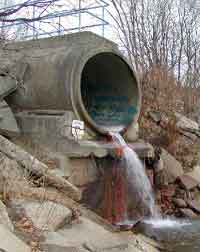 Alberta's WaterIntroductionPublications Climate Change Industrial Impacts Agricultural Impacts Urban Impacts Biodiversity Loss Definitions Links Site Map |
 |
|
 |
| What remains of Groat Creek, which was paved to create Groat Road. |
Various studies in the '90s showed that the aquatic impact was linked to the impervious area such as pavement and concrete in water catchments, and that beyond 20% impervious area, streams begin to be severely affected. They concluded that perhaps the only prevention was to limit watershed development. This task only becomes more difficult, however, as the population booms.
Edmonton's population in 2001 was approximately 670,000 with a greater metropolitan population of 940,000, a growth of more than 8% from the previous census of 1996. Part of the current growth is being accommodated by new developments along Whitemud Creek, Blackmud Creek, Fulton Creek, and in marsh areas in the city's north end.
Objectives
- Develop an understanding of bioregional mapping and explore its relevance to city planning in Edmonton
- Begin a documentation of Edmonton's "lost" creeks and wetlands
- Create a graphic and geographic account of impacts to aquatic systems within the City of Edmonton
- Produce a map of "Lost Creeks and Wetlands of Edmonton", to serve as a focus for evaluating urban impacts and a tool for directing future growth.



 Lost Creeks and Wetlands of Edmonton
Lost Creeks and Wetlands of Edmonton